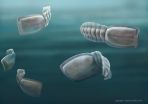(Press-News.org) CORVALLIS, Ore. – Since the first undersea methane seep was discovered 30 years ago, scientists have meticulously analyzed and measured how microbes in the seafloor sediments consume the greenhouse gas methane as part of understanding how the Earth works.
The sediment-based microbes form an important methane "sink," preventing much of the chemical from reaching the atmosphere and contributing to greenhouse gas accumulation. As a byproduct of this process, the microbes create a type of rock known as authigenic carbonate, which while interesting to scientists was not thought to be involved in the processing of methane.
That is no longer the case. A team of scientists has discovered that these authigenic carbonate rocks also contain vast amounts of active microbes that take up methane. The results of their study, which was funded by the National Science Foundation, were reported today in the journal Nature Communications.
"No one had really examined these rocks as living habitats before," noted Andrew Thurber, an Oregon State University marine ecologist and co-author on the paper. "It was just assumed that they were inactive. In previous studies, we had seen remnants of microbes in the rocks – DNA and lipids – but we thought they were relics of past activity. We didn't know they were active.
"This goes to show how the global methane process is still rather poorly understood," Thurber added.
Lead author Jeffrey Marlow of the California Institute of Technology and his colleagues studied samples from authigenic compounds off the coasts of the Pacific Northwest (Hydrate Ridge), northern California (Eel River Basin) and central America (the Costa Rica margin). The rocks range in size and distribution from small pebbles to carbonate "pavement" stretching dozens of square miles.
"Methane-derived carbonates represent a large volume within many seep systems and finding active methane-consuming archaea and bacteria in the interior of these carbonate rocks extends the known habitat for methane-consuming microorganisms beyond the relatively thin layer of sediment that may overlay a carbonate mound," said Marlow, a geobiology graduate student in the lab of Victoria Orphan of Caltech.
These assemblages are also found in the Gulf of Mexico as well as off Chile, New Zealand, Africa, Europe – "and pretty much every ocean basin in the world," noted Thurber, an assistant professor (senior research) in Oregon State's College of Earth, Ocean, and Atmospheric Sciences.
The study is important, scientists say, because the rock-based microbes potentially may consume a huge amount of methane. The microbes were less active than those found in the sediment, but were more abundant – and the areas they inhabit are extensive, making their importance potential enormous. Studies have found that approximately 3-6 percent of the methane in the atmosphere is from marine sources – and this number is so low due to microbes in the ocean sediments consuming some 60-90 percent of the methane that would otherwise escape.
Now those ratios will have to be re-examined to determine how much of the methane sink can be attributed to microbes in rocks versus those in sediments. The distinction is important, the researchers say, because it is an unrecognized sink for a potentially very important greenhouse gas.
"We found that these carbonate rocks located in areas of active methane seeps are themselves more active," Thurber said. "Rocks located in comparatively inactive regions had little microbial activity. However, they can quickly activate when methane becomes available.
"In some ways, these rocks are like armies waiting in the wings to be called upon when needed to absorb methane."
The ocean contains vast amounts of methane, which has long been a concern to scientists. Marine reservoirs of methane are estimated to total more than 455 gigatons and may be as much as 10,000 gigatons carbon in methane. A gigaton is approximate 1.1 billion tons.
By contrast, all of the planet's gas and oil deposits are thought to total about 200-300 gigatons of carbon.
INFORMATION:
Just 14 per cent of the population has an Advance Directive, or "living will", detailing their end of life treatment and care preferences, according to an article led by QUT Australian Centre for Health Law Research director Professor Ben White.
This research is from a joint University of Queensland, QUT and Victoria University study, supported by the Australian Research Council in partnership with seven public trustee organisations across Australia.
An Advance Directive is a legal document in which a person specifies what treatment or end of life care they want, when ...
ITHACA, N.Y. – Have you ever noticed you find your candidate for political office more attractive than the opponent? New research from Cornell University shows you're not the only one.
"We showed pictures of familiar and unfamiliar political leaders to voters in two different samples and found that familiarity and partisanship each significantly influenced how candidates were perceived," said the study's lead researcher, said Kevin M. Kniffin, a postdoctoral research associate at Cornell's Dyson School of Applied Economics and Management. "For example, Democrats ...
PULLMAN, Wash. – With global food demand expected to outpace the availability of water by the year 2050, consumers can make a big difference in reducing the water used in livestock production.
"It's important to know that small changes on the consumer side can help, and in fact may be necessary, to achieve big results in a production system," said Robin White, lead researcher of a Washington State University study appearing in the journal Food Policy.
WSU economist Mike Brady demonstrated that the willingness of consumers to pay a little more for meat products labeled ...
More than 100 years since they were first discovered, some of the world's most bizarre fossils have been identified as distant relatives of humans, thanks to the work of University of Adelaide researchers.
The fossils belong to 500-million-year-old blind water creatures, known to scientists as "vetulicolians" (pronounced: ve-TOO-lee-coal-ee-ans).
Alien-like in appearance, these marine creatures were "filter-feeders" shaped like a figure-of-8. Their strange anatomy has meant that no-one has been able to place them accurately on the tree of life, until now.
In a new ...
Philadelphia, PA, October 15, 2014 – Are deficits in attention limited to those with attention-deficit/hyperactivity disorder (ADHD) or is there a spectrum of attention function in the general population? The answer to this question has implications for psychiatric diagnoses and perhaps for society, broadly.
A new study published in the current issue of Biological Psychiatry, by researchers at Cardiff University School of Medicine and the University of Bristol, suggests that there is a spectrum of attention, hyperactivity/impulsiveness and language function in society, ...
Galaxy clusters are the largest objects in the Universe held together by gravity but their formation is not well understood. The Spiderweb Galaxy (formally known as MRC 1138-262 [1]) and its surroundings have been studied for twenty years, using ESO and other telescopes [2], and is thought to be one of the best examples of a protocluster in the process of assembly, more than ten billion years ago.
But Helmut Dannerbauer (University of Vienna, Austria) and his team strongly suspected that the story was far from complete. They wanted to probe the dark side of star formation ...
Obtaining access to private outpatient psychiatric care in the Boston, Chicago and Houston metropolitan areas is difficult, even for those with private insurance or those willing to pay out of pocket, a new study by Harvard researchers shows.
The researchers, who posed on the phone as patients seeking appointments with individual psychiatrists, encountered numerous obstacles, including unreturned calls, wrong numbers and providers who were no longer taking new patients. They met with success in only one-quarter of their attempts, even after two tries.
These and related ...
DURHAM, N.C. – Like discriminating thieves, prostate cancer tumors scavenge and hoard copper that is an essential element in the body. But such avarice may be a fatal weakness.
Researchers at Duke Medicine have found a way to kill prostate cancer cells by delivering a trove of copper along with a drug that selectively destroys the diseased cells brimming with the mineral, leaving non-cancer cells healthy.
The combination approach, which uses two drugs already commercially available for other uses, could soon be tested in clinical trials among patients with late-stage ...
A new study published in Cancer Research shows SIRT6—a protein known to inhibit the growth of liver and colon cancers—can promote the development of skin cancers by turning on an enzyme that increases inflammation, proliferation and survival of sun-damaged skin cells.
Previously considered protective, SIRT6 is part of a family of seven proteins called sirtuins that help regulate genomic stability and prevent some of the genetic flaws associated with aging. SIRT6 helps repair DNA damage, which can lead to cancer. This study, in the journal's October 15 issue, ...
Risk factors for sexual assault, including young age and alcohol consumption, must be addressed when considering preventative strategies, suggests a new study, published today (15 October) in BJOG: An International Journal of Obstetrics and Gynaecology (BJOG).
The Danish study used data from all women attending the specialised centre for victims of sexual assault (CVSA) in Copenhagen for sexual assault or attempted sexual assault between March 2001 and December 2010. A total of 2541 women were included in the sample.
The study aimed to describe the victims of sexual ...

